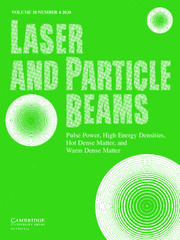Crossref Citations
This article has been cited by the following publications. This list is generated based on data provided by
Crossref.
Korovin, S. D.
Lyubutin, S. K.
Mesyats, G. A.
Rostov, V. V.
Rukin, S. N.
Slovikovsky, B. G.
Ul’maskulov, M. R.
Sharypov, K. A.
Shpak, V. G.
Shunailov, S. A.
and
Yalandin, M. I.
2004.
Generation of subnanosecond 10-GHz pulses in high peak and high average power mode.
Technical Physics Letters,
Vol. 30,
Issue. 9,
p.
719.
Eltchaninov, A.A.
Korovin, S.D.
Mesyats, G.A.
Pegel, I.V.
Rostov, V.V.
Shpak, V.G.
and
Yalandin, M.I.
2004.
Review of Studies of Superradiative Microwave Generation in X Band and Ka Band Relativistic BWOs (Review).
IEEE Transactions on Plasma Science,
Vol. 32,
Issue. 3,
p.
1093.
S.K. Luybutin, S.N. Rukin
2004.
Nanosecond pulsewidth rybrid modulator.
p.
539.
Mesyats, G.A.
Korovin, S.D.
Rostov, V.V.
Shpak, V.G.
and
Yalandin, M.I.
2004.
The RADAN series of compact pulsed power Generators and their applications.
Proceedings of the IEEE,
Vol. 92,
Issue. 7,
p.
1166.
Luybutin, S.K.
Rukin, S.N.
Sharypov, K.A.
Shpak, V.G.
Shunailov, S.A.
Slovikovsky, B.G.
Ulmaskulov, M.R.
Yalandin, M.I.
Korovin, S.D.
and
Rostov, V.V.
2005.
Nanosecond hybrid Modulator for the fast-repetitive driving of X-band, gigawatt-power microwave source.
IEEE Transactions on Plasma Science,
Vol. 33,
Issue. 4,
p.
1220.
Mesyats, Gennadii A.
and
Yalandin, Mikhail I.
2005.
High-power picosecond electronics.
Uspekhi Fizicheskih Nauk,
Vol. 175,
Issue. 3,
p.
225.
Korovin, S. D.
Eltchaninov, A. A.
Rostov, V. V.
Shpak, V. G.
Yalandin, M. I.
Ginzburg, N. S.
Sergeev, A. S.
and
Zotova, I. V.
2006.
Generation of Cherenkov superradiance pulses with a peak power exceeding the power of the driving short electron beam.
Physical Review E,
Vol. 74,
Issue. 1,
Ginzburg, N. S.
Korovin, S. D.
Pegel, I. V.
Rostov, V. V.
and
Yalandin, M. I.
2006.
Production of ultra-short high-power microwave pulses in Čerenkov backward-wave systems (Review).
Laser Physics,
Vol. 16,
Issue. 1,
p.
79.
Ginzburg, N. S.
Zotova, I. V.
Pegel’, I. V.
Rostov, V. V.
Shpak, V. G.
and
Yalandin, M. I.
2007.
Generation of high-power ultrashort electromagnetic pulses on the basis of effects of superradiance of electron bunches.
Radiophysics and Quantum Electronics,
Vol. 50,
Issue. 10-11,
p.
762.
Li, G. L.
Yuan, C. W.
Zhang, J. Y.
Shu, T.
and
Zhang, J.
2008.
A diplexer for gigawatt class high power microwaves.
Laser and Particle Beams,
Vol. 26,
Issue. 3,
p.
371.
Rostov, V.V.
Yalandin, M.I.
and
Mesyats, G.A.
2008.
Repetitive Production of Nanosecond Gigawatt Microwave Pulses.
IEEE Transactions on Plasma Science,
Vol. 36,
Issue. 3,
p.
655.
Wenyuan Yang
2009.
Numerical Studies on a Novel Coaxial Single-Pass Superradiance Relativistic Backward-Wave Oscillator.
IEEE Transactions on Plasma Science,
Vol. 37,
Issue. 7,
p.
1246.
Xiao, R.Z.
Zhang, X.W.
Zhang, L.J.
Li, X.Z.
Zhang, L.G.
Song, W.
Hu, Y.M.
Sun, J.
Huo, S.F.
Chen, C.H.
Zhang, Q.Y.
and
Liu, G.Z.
2010.
Efficient generation of multi-gigawatt power by a klystron-like relativistic backward wave oscillator.
Laser and Particle Beams,
Vol. 28,
Issue. 3,
p.
505.
Zhang, Qiang
Yuan, Chengwei
and
Liu, Lie
2010.
Design of a dual-band power combining architecture for high-power microwave applications.
Laser and Particle Beams,
Vol. 28,
Issue. 3,
p.
377.
El’chaninov, A. A.
Klimov, A. I.
Koval’chuk, O. B.
Mesyats, G. A.
Pegel’, I. V.
Romanchenko, I. V.
Rostov, V. V.
Sharypov, K. A.
and
Yalandin, M. I.
2011.
Coherent summation of power of nanosecond relativistic microwave oscillators.
Technical Physics,
Vol. 56,
Issue. 1,
p.
121.
Rostov, V.V.
Elchaninov, A.A.
Romanchenko, I.V.
Yalandin, M. I.
and
Mesyats, G.A.
2011.
Amlitude and phase control of superradiation pulses by the magnetic bias of saturated ferrite.
p.
647.
He, Juntao
Cao, Yibing
Zhang, Jiande
Wang, Ting
and
Ling, Junpu
2011.
Design of a dual-frequency high-power microwave generator.
Laser and Particle Beams,
Vol. 29,
Issue. 4,
p.
479.
Qi, Zumin
Zhang, Jun
Zhong, Huihuang
and
Zhang, Zehai
2012.
A large-signal theory of bunching in the triaxial klystron amplifier.
Laser and Particle Beams,
Vol. 30,
Issue. 4,
p.
569.
Yalandin, M. I.
Shunailov, S. A.
Ul’maskulov, M. R.
Sharypov, K. A.
Shpak, V. G.
Rostov, V. V.
Romanchenko, I. V.
El’chaninov, A. A.
and
Klimov, A. I.
2012.
Synphase operation of nanosecond relativistic 37-GHz backward-wave oscillators without electrodynamic coupling.
Technical Physics Letters,
Vol. 38,
Issue. 10,
p.
917.
Rostov, V. V.
Elchaninov, A. A.
Romanchenko, I. V.
and
Yalandin, M. I.
2012.
A coherent two-channel source of Cherenkov superradiance pulses.
Applied Physics Letters,
Vol. 100,
Issue. 22,


